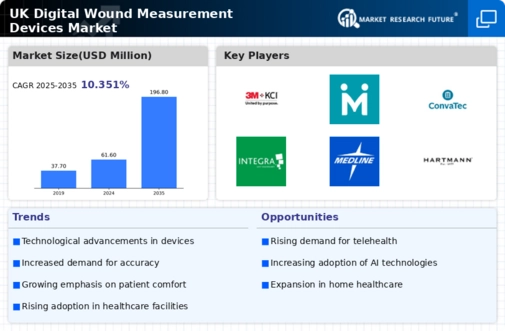Supportive Healthcare Policies
Supportive healthcare policies in the UK are fostering an environment conducive to the growth of the digital wound-measurement-devices market. Government initiatives aimed at improving healthcare delivery and patient outcomes are encouraging the adoption of innovative medical technologies. Policies that promote the use of digital health solutions are likely to enhance the accessibility and affordability of digital wound-measurement devices. Furthermore, funding programs and incentives for healthcare providers to integrate these technologies into their practices are expected to drive market expansion. As the UK government continues to prioritize advancements in healthcare, the digital wound-measurement-devices market may experience a surge in demand, potentially leading to a market size increase of 10% by 2026.
Growing Awareness of Wound Care
There is a growing awareness of the importance of effective wound care among both healthcare professionals and patients in the UK. This heightened awareness is driving the demand for advanced wound management technologies, including digital wound-measurement devices. Educational initiatives and campaigns aimed at improving knowledge about wound care are contributing to this trend. As healthcare providers increasingly recognize the benefits of accurate wound assessment and monitoring, the digital wound-measurement-devices market is likely to expand. The market is projected to reach a valuation of approximately £200 million by 2027, reflecting the increasing investment in innovative wound care solutions that enhance patient outcomes.
Rising Incidence of Chronic Wounds
The increasing prevalence of chronic wounds in the UK is a notable driver for the digital wound-measurement-devices market. Conditions such as diabetes and venous ulcers are becoming more common, leading to a heightened demand for effective wound management solutions. According to recent data, chronic wounds affect approximately 1-2% of the UK population, which translates to a significant number of patients requiring advanced care. This growing patient base necessitates the adoption of digital wound-measurement devices, which offer precise measurements and improved monitoring capabilities. As healthcare providers seek to enhance treatment outcomes and reduce healing times, The digital wound-measurement-devices market will likely experience substantial growth, driven by the need for innovative solutions to manage these complex conditions.
Integration of Telehealth Solutions
The integration of telehealth solutions within the healthcare system is emerging as a critical driver for the digital wound-measurement-devices market. With the increasing adoption of remote patient monitoring, healthcare providers are leveraging digital technologies to enhance patient care. Digital wound-measurement devices facilitate real-time data sharing between patients and healthcare professionals, allowing for timely interventions and adjustments to treatment plans. This trend is particularly relevant in the UK, where the National Health Service (NHS) is actively promoting telehealth initiatives. The digital wound-measurement-devices market stands to benefit from this shift, as it aligns with the broader movement towards digital health solutions, potentially leading to a market growth rate of around 15% annually over the next few years.
Technological Innovations in Healthcare
Technological innovations in healthcare are significantly influencing the digital wound-measurement-devices market. The advent of advanced imaging technologies, such as 3D scanning and artificial intelligence, is revolutionizing the way wounds are assessed and monitored. These innovations enable healthcare professionals to obtain precise measurements and detailed analyses of wounds, leading to more effective treatment strategies. In the UK, the healthcare sector is increasingly investing in research and development to enhance these technologies, which is likely to drive market growth. As the digital wound-measurement-devices market evolves, it may witness a compound annual growth rate (CAGR) of around 12% over the next five years, reflecting the ongoing commitment to improving patient care through technological advancements.


















Leave a Comment